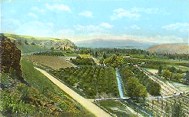The fruit-growing regions of Washington state, which are surrounded by the magnificent Cascade Mountains, have been producing large yields of apples for much of the last century. From the small family farms, which sprang up from the earliest settlements in this area during the 1870s, to the large corporations, which today both grow and process fruits of all kinds, agri-business was and remains an integral, vibrant way of life for our state's residents.
We would like to share the story and the breath-taking beauty of Washington' s fruit orchards with all of our many visitors. Since there is more to see and experience than a single tour through our state's apple country can accommodate, we hope you will want to plan a return visit.
Apple Growing

Washington's oldest fruit orchards date back to approximately the mid-1870s.
It was at that time that those new arrivals who had come west to farm, rather
than to seek gold or minerals, began to establish permanent settlements.
read more
Apple Packing
The production of tree fruits is one of the dominant industries in all of Washington state. Final market destinations range from the local farm markets and grocery stores to national and world-wide export. In order to ensure that the highest quality product is guaranteed for consumers the world over, Washington-based packing companies have a dedicated and impressive history which may be traced back to the early years of the twentieth century. Many of the modern-day enterprises were founded by the great grand-parents of those who now own and operate them.
read more
Apple Processing
Of all the attendant industries, apple processing would prove to have the largest impact on the increasingly robust agri-business in this region. Prior to 1915, orchardists simply dumped their blemished or deformed apples, called 'cull,' into the Columbia River. In 1916, a Chelan businessman named George F. Miller proposed to the ochardists that he be permitted to purchase these belmished apples in order to sell the cull to various juice processing and fruit canning operations, which were then primarily based in the Puget Sound region. Growers were delighted with this idea, and readily accepted Miller's commissions.
read more
Regional Histories
Wenatchee: Local Native American lore claims that the name Wenatchee (Wa-Nat-Chee) derives from a poetic description of the area meaning "robe of the rainbow." The valley's lush panorama is poetic majesty indeed. Resting at 600 feet above sea level, Wenatchee is surrounded by the Central Cascades Mountain Range.
read more
Cashmere: One of the most resplendent and fecund regions in the Wenatchee Valley, the city of Cashmere lies nestled among the foothills of the Cascade mountains, near to the geographic center of Washington state.
read more
Chelan: The beautiful Indian word means "deep water." Lake Chelan commands the northeast section of the county which bears its name, and is one of the most pristine bodies of water in the United States.
read more
Leavenworth: Throughout its history, Leavenworth has undergone many incarnations. As with other parts of the state, explorers, trappers and a handful of settlers entered the area in the early 1800's and, by the mid-nineteenth century, a steady stream of homesteaders began to populate the area.
read more
History of the Region's Railroads
The Great Northern: One of two principal railroads which initially traversed this country from east to west was James J Hill's Great Northern. Formerly known as the Minnesota & Pacific Railroad, the company had been in receivership to territory of Minnesota for a number of years. Unable to meet the fiduciary obligations under its founding charter (c. 1857), the rail line was in chronic need of investors and operating capital. In 1878 its holdings were reorganized as the St. Paul, Minneapolis & Manitoba Railway Company, and James Hill assumed the reigns as general manager.
read more
The Northern Pacific: At the height of the Civil War during the summer of 1864, on 2 July, Abraham Lincoln signed into law the official Act of Congress which created the Northern Pacific Railroad Company. This particular bill was significant because it awarded to Northern Pacific the largest land grant which had been rendered to any private corporation at the time: more than forty million acres.
read more





